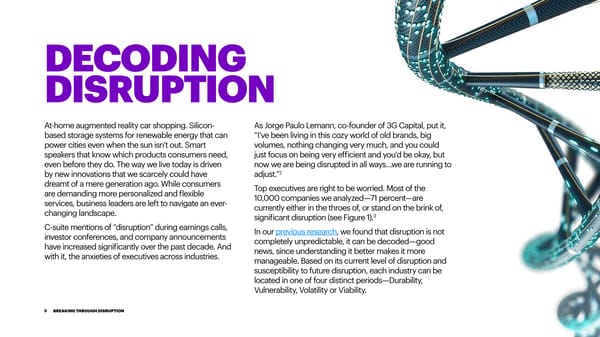DECODING DISRUPTION At-home augmented reality car shopping. Silicon- As Jorge Paulo Lemann, co-founder of 3G Capital, put it, based storage systems for renewable energy that can “I’ve been living in this cozy world of old brands, big power cities even when the sun isn’t out. Smart volumes, nothing changing very much, and you could speakers that know which products consumers need, just focus on being very efficient and you’d be okay, but even before they do. The way we live today is driven now we are being disrupted in all ways…we are running to by new innovations that we scarcely could have adjust.”2 dreamt of a mere generation ago. While consumers Top executives are right to be worried. Most of the are demanding more personalized and flexible 10,000 companies we analyzed—71 percent—are services, business leaders are left to navigate an ever- currently either in the throes of, or stand on the brink of, changing landscape. 3 significant disruption (see Figure 1). C-suite mentions of “disruption” during earnings calls, In our previous research, we found that disruption is not investor conferences, and company announcements completely unpredictable, it can be decoded—good have increased significantly over the past decade. And news, since understanding it better makes it more with it, the anxieties of executives across industries. manageable. Based on its current level of disruption and susceptibility to future disruption, each industry can be located in one of four distinct periods—Durability, Vulnerability, Volatility or Viability. 5 BREAKING THROUGH DISRUPTION
 Breaking Through Disruption Page 4 Page 6
Breaking Through Disruption Page 4 Page 6